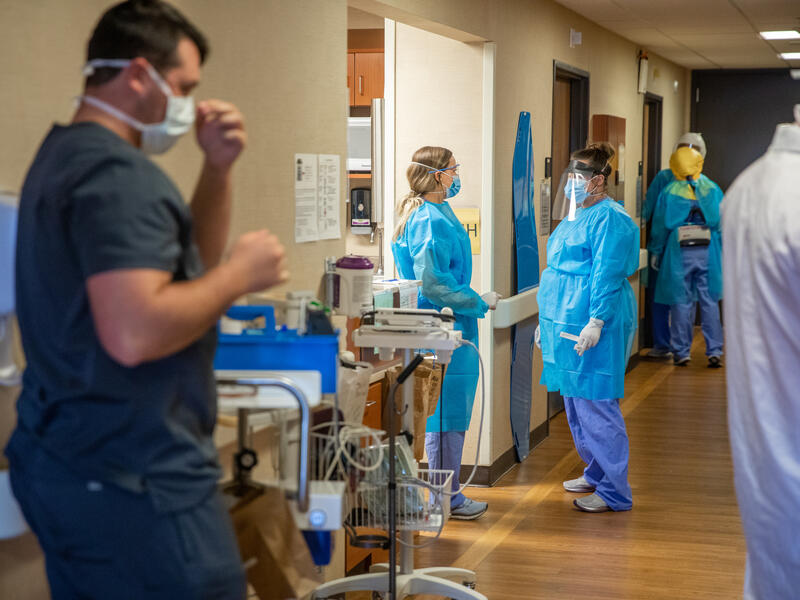The number of patients hospitalized at Sanford Health surpassed 1,400 this week which is right at the maximum number of people it can hold.
“When we get to that point, we have to start making choices,” Chief Physician Jeremy Cauwels, M.D., said in a Facebook Live Q&A on Oct. 7.
“We have to start making choices about how many surgeries we do, about which surgeries we do and about how quickly we can get to all of the people we want to get to and provide services to. Unfortunately, we can’t hold on heart attacks. We can’t hold on strokes. We have to take care of those people. We can’t hold on broken bones and car accidents.”
What we have the most control over right now is preventing hospitalizations due to COVID-19, he said.
COVID hospitalizations are preventable
The number of patients in hospital beds with COVID-19 jumped from 170 to 189 in two days.
A majority of those patients are still unvaccinated.
“Our behavior directly influences how many people come into the hospital,” he told Sanford Health News.
“That’s the reason that Sanford is highly encouraging the vaccine, that’s the reason we encourage so much masking and social distancing and washing your hands. If we can keep that number flat and not get higher than 189, we can continue to do the good work that our nurses and doctors do every day to help make sure that we can help everyone who needs it.”
The death toll from COVID-19 in the United States has reached 700,000 people in under two years.
“That’s more than the world wars, and it’s more than the Spanish Flu of 1920,” he said. “This is the pandemic of not only our time, but in U.S. history. Because of that, we take it very seriously and do what we can to protect not only ourselves, but our fellow man and the other people walking around on the street with us.”
COVID’s impact on rural America
Rural Americans are dying of the coronavirus at more than twice the rate of those in bigger cities.
A recent report by the Rural Policy Research Institute published by PBS focuses on the population that tends to be older, sicker, poorer and less vaccinated.
“For this kind of population, it’s important to recognize they don’t count most of the metro of Sioux Falls or Fargo as a ‘big city,'” Dr. Cauwels explained. “So, all of the areas around us are considered rural.”
He said the combination of difficulty getting to care at times, lack of interest in wanting to get care and not getting the vaccine will put people at a higher risk for COVID-related trouble than those in larger cities.
Pfizer’s vaccine for kids
Big news from Pfizer and BioNTech came Oct. 7.
Leaders at Pfizer and BioNTech announced they are seeking U.S. Food and Drug Administration emergency use authorization from for their Covid-19 vaccine for children ages 5 to 11.
“This is what we expected,” Dr. Cauwels said. “This is why they were doing extra research, bringing in extra kids to prove this was safe and now they have all that research done.”
If authorized, this would be the first COVID-19 vaccine for younger children. The Pfizer/BioNTech vaccine is approved for people age 16 and older and has an emergency use authorization for people ages 12 to 15.
He said the FDA scheduled an advisory committee meeting for Oct. 26, in anticipation of receiving request from Pfizer to allow pediatric vaccines to be administered to children 5-11.
Why give kids the vaccine?
For the sake of public health, Dr. Cauwels said the vaccine has proven to decrease the amount of circulating virus in communities.
Data has proven the risks are greater with COVID-19 illness than the vaccine for adults and he expects that to be consistent in children.
On top of that, parents don’t want kids missing school or have to face any long-term effects of the virus. Both of those are common among kids who are not vaccinated.
Wondering about how the dosage differs for kids 5-11?
Dr. Cauwels said that age group will get a third of the dose that adults receive – which is 30 micrograms. Preliminary studies are showing doses for the youngest children are 10 times less.
Information in this story was accurate when it was posted. As the COVID-19 pandemic changes, scientific understanding and guidelines may have changed since the original publication date.
Read more
…
Posted In COVID-19, Expert Q&A, Immunizations, Rural Health

